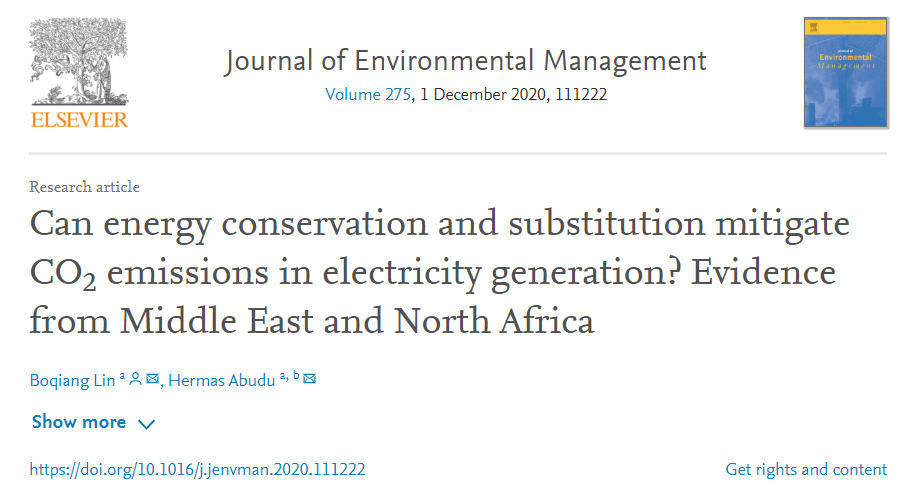
题目:节能行为和能源替代可以减少电力部门的CO2排放吗?来自中东和北非的证据(Can energy conservation and substitution mitigate CO2 emissions in electricity generation? Evidence from Middle East and North Africa)
作者:林伯强*,Hermas Abudu
期刊:环境管理(Journal of Environmental Management)
详细:275卷,2020年12月,111222
DOI:https://doi.org/10.1016/j.jenvman.2020.111222
文献导读:
根据政府间气候变化专门委员会(IPCC)在2007年的预测,在经济增长的驱动作用下,发展中国家将成为21世纪全球二氧化碳排放增量的主要贡献者。为了减少二氧化碳排放并推动全球的可持续发展,联合国在2015年制定了实现17个可持续发展目标(SDG)的框架。此背景给一些发展中国家能源政策的制定带来了诸多约束。比如,中东和北非(MENA)地区在当前面临着相关可持续发展目标的挑战。此外,与一些发达地区相比,中东和北非地区的能源强度很高。中东和北非国家政府的能源补贴干预作用并没有赋予能源市场足够的激励来推进技术变革,因此清洁能源的应用水平和普及率并不充分。
本文的研究动机源于面临气候变化挑战背景下中东和北非地区的环境不确定性。因此,本文研究的具体议题是清洁和可负担的能源政策(SDG7)的实施是否会支撑中东和北非地区在2030年前的经济增长?此外,要素间和燃料间替代的技术变革能否支撑实现可持续发展目标SDG13?基于对以上问题的思考,本文通过扩展随机前沿以及超越对数生产函数模型估算中东和北非地区的能源强度和效率,并采用生命周期分析(LCA)框架探讨能源消耗对中东和北非地区经济增长和环境的影响。本文的研究结论对于相关地区的可持续发展具有重要意义。
Abstract: This study objectively investigates the influence of energy conservation and substitution strategies in mitigating CO2 emissions in the electricity generation sector in Middle East and North Africa (MENA) region. The paper specifically explores if climate action implementation may negatively affect energy consumption on economic growth ambition and whether technical change in factor and inter-fuel substitution support in achieving sustainable development goals (SDGs) 7, 8 &13. This paper conducts the study under the life cycle analysis (LCA) procedure. We also apply stochastic frontier Translog production and ridge regression techniques with data for 2000–2015. The results currently show that renewable energy intensity falls below the breakeven level. Meanwhile, nonrenewable energy intensity is much higher. Furthermore, production factors and inter-fuel technological change show that capital-energy and renewable-nonrenewable energy are perfect substitutes under the electricity sector. Moreover, the findings reveal low energy efficiency of 40 percent with poor carbon performance. We, therefore, conclude that MENA region may not achieve cleaner, affordable energy and climate action concurrently with economic growth under the current production technologies by the fiscal year 2030. We further conclude that economic growth is presently inversely related to energy efficiency but positively with energy intensity. This suggests that MENA region economic growth drive is highly linked with nonrenewable consumption and also not supporting energy conservation strategies. Additionally, we conclude that energy efficiency improvement and reduction in energy intensity may not be achieved as the governments keep subsidizing electricity in the region. Besides, the more policymakers pursue economic growth through energy intensity indicators, the more energy is consumed through the energy rebound effects. Based on these findings and conclusions, we recommend insightful strategies under the electricity sector. This study adds new body of knowledge by extending Translog production to estimate energy intensity & efficiency under the LCA procedure. Scholars also contribute to data and variable modeling under the SDGs in discovering CO2 emission mitigation in the electricity sector which could be replicated in other countries or regions.
Keywords: Decarbonizing electricity sector, Carbon efficiency frontier, Eco-efficiency, Renewable energy substitution prospects, Stochastic frontier translog technique
 厦大总机:0592-2180000
|
地址:福建省厦门市思明区思明南路422号
|
邮政编码:361005
厦大总机:0592-2180000
|
地址:福建省厦门市思明区思明南路422号
|
邮政编码:361005